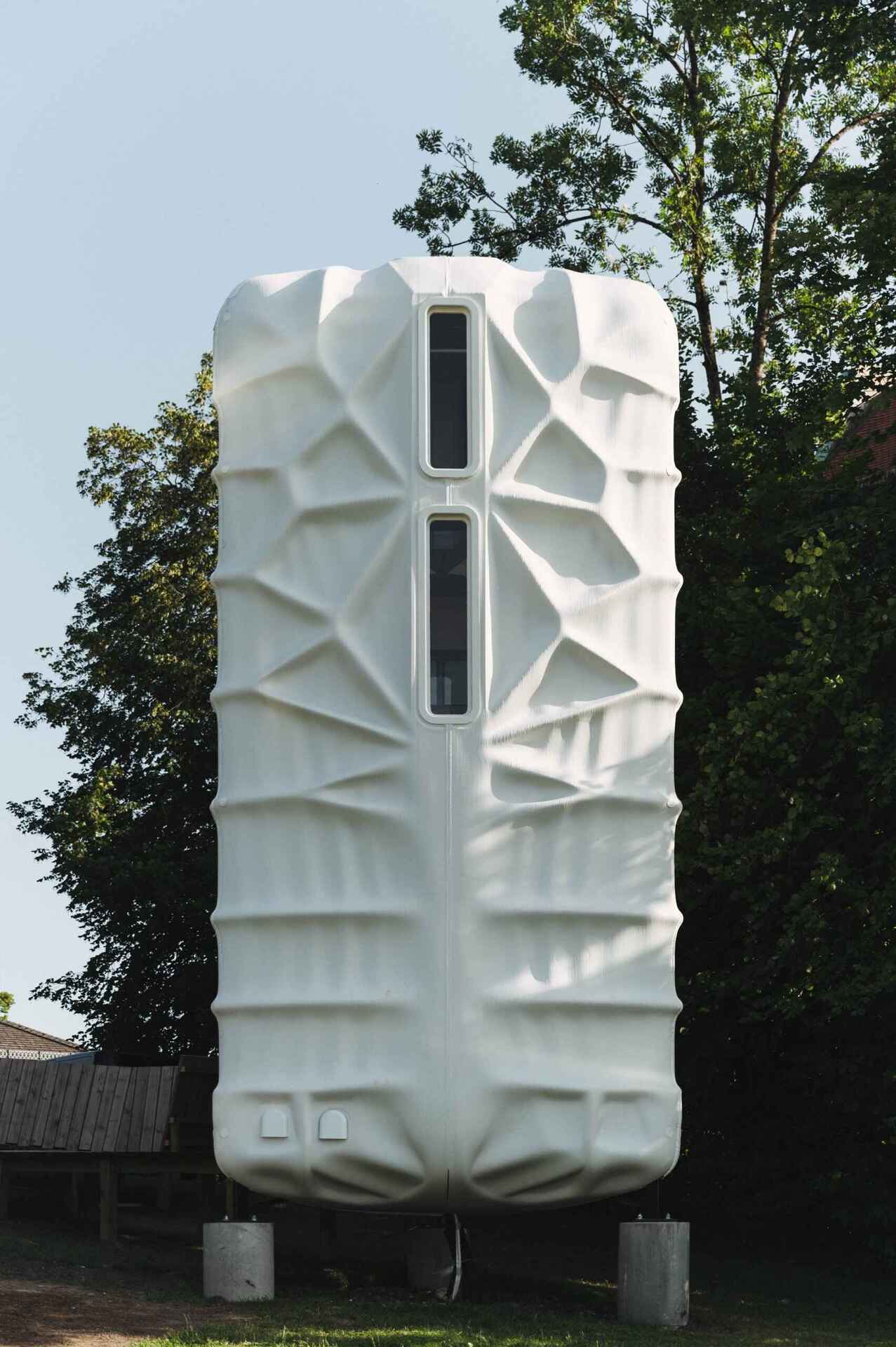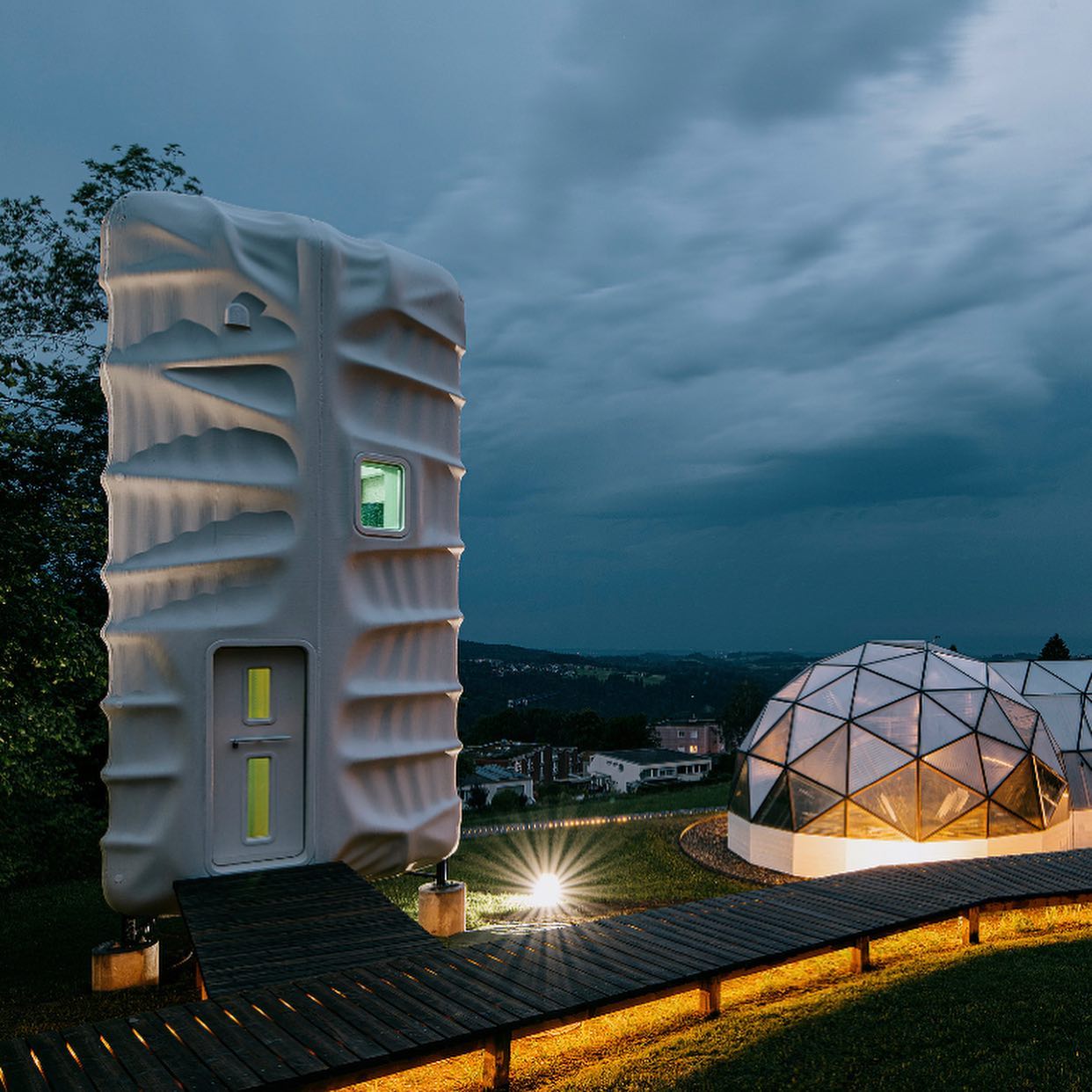Our solar system has an incredible variety of worlds, and recent research has identified several off-Earth locations as potentially habitable for humans, like Mars, Europa, Enceladus, and the Moon. With NASA aiming to send astronauts to the Moon around 2026 and Mars by the late 2030s or early 2040s, there is an opportunity to create a thriving space economy, and that includes habitats for crews to live in. Several visions have been in the works, especially 3D-printed ones, like AI Space Factory’s egg-shaped Martian home or Icon’s Mars Dune Alpha 3D-printed habitat located at Johnson Space Center in Houston, Texas. One of the latest to join the ranks of futuristic space structures is the Rosenberg Space Habitat (RSH) 3D printed polymer habitat.
The 3D Printed Rosenberg Space Habitat
Described as one of the tallest 3D printed polymer structures, the 23-feet high RSH was designed by school-aged students at the Swiss Institut auf dem Rosenberg in collaboration with SAGA Space Architects and constructed to fit into SpaceX’s Starship rocket. Beyond its potential use in distant orbits, the structure will also have an instrumental life on Earth. Students at the boarding school will have the opportunity to use it for immersive learning modules that activate creative problem solving by interconnecting arts, science, and technology, as well as promoting data literacy while coexisting with intelligent machines such as a resident built-in Spot robot from partner Boston Dynamics.
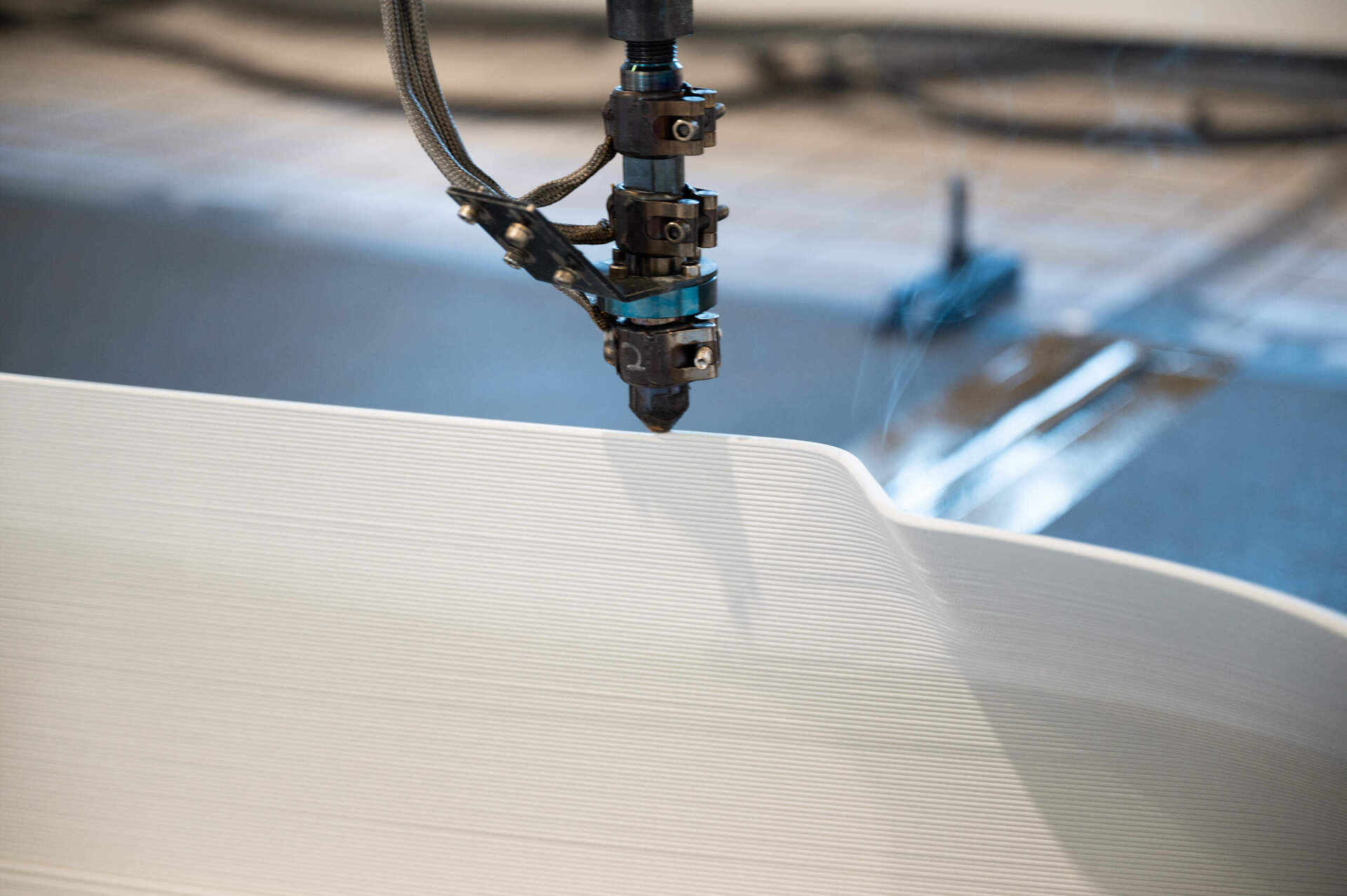
3D printing the Rosenberg Space Habitat (RSH)’s outer shell. Image courtesy of SAGA Space Architects.
Visually stunning, the RSH’s outer shell was built by high-tech partner Ingersoll using one of its largest 3D printers at their plant in Milan, on top of an interior structure built in Copenhagen. The Rosenberg-specific recipe for its design includes a UV stabilizer that results in a flexible yet durable material that is recyclable – it can be broken down and reprinted into a different structure.
Given Starship’s promise as a future means of transportation in space, the team behind this project decided to design it around it as the primary transportation platform. SAGA explained that given the cylindrical nature of the Starship cargo bay, the first designs had a circular shape. Then the SAGA team began building the interior frames for each module from laser-cut steel, added the electrical work, and controlled the 3D printing of the exterior shell at Ingersoll.
When the modules were finished, the insulation provided by Armacell was added to the exterior, and the structure was shipped to Switzerland. After fitting all the modules and the base feet, the last step was fitting the 3D printed panels onto the fully stacked habitat.
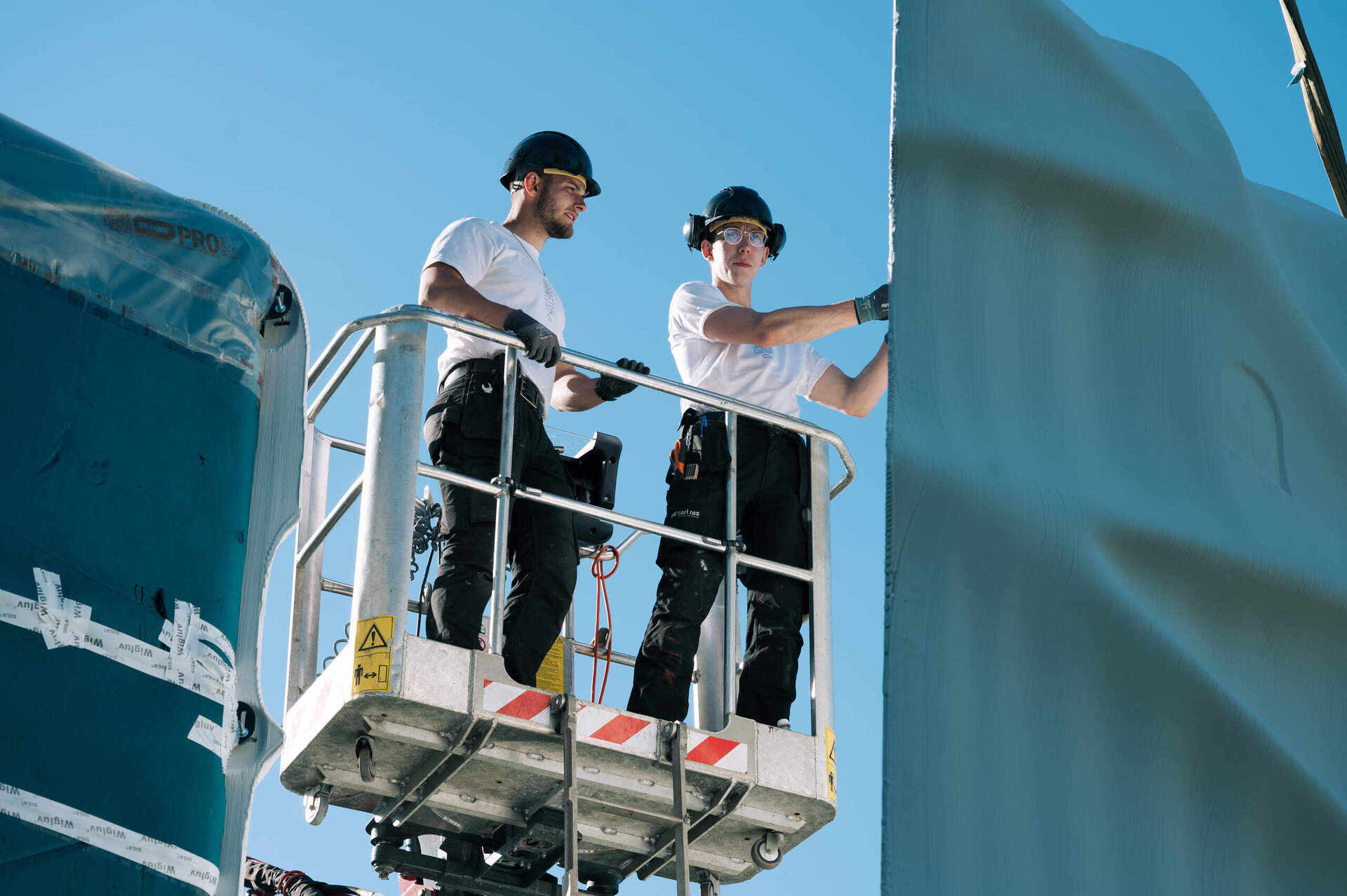
The SAGA Space Architects team installed the Rosenberg Space Habitat (RSH) 3D printed polymer habitat in Switzerland. Image courtesy of SAGA Space Architects.
SAGA and Rosenberg students (ages six to 18) closely collaborated over two years to execute the vessel’s design, which started with creative problem-solving activities during SAGA Space’s Lunar mission in Greenland, where the company tested their Lunark habitat for a hundred days. Inspired by this experience, students collaborated closely with SAGA to design a Rosenberg Habitat to house Rosenberg’s resident Spot robot with initial creative concepts and paper models.
Building on SAGA’s learnings from Lunark, RSH is a space-optimized structure consisting of two and a half floors for a crew of two persons. Housed at the Rosenberg Future Park – a state-of-the-art outdoor experimental facility powered by wind trees at the pioneering boarding school – this “extraterrestrial” learning environment for students will allow lab research and a robotic workshop on the first floor. The second floor is dedicated to work, recreation, and entertainment, while the last story is intended for privacy and rest. With mental well-being and sustainability at the forefront of the design, the space uses Vitra furniture, designed to be multi-functional, allowing for multiple activities within the limited space in the vessel.

Inside the Rosenberg Space Habitat (RSH) 3D printed polymer habitat. Image courtesy of Institut auf dem Rosenberg.
Infusing Education with Real-Life Context
According to Rosenberg’s general director, Bernhard Gademann, “infusing education with real-life context” is at the heart of what the school does. Rather than focusing on pure academics alone, it aims to provide future leaders with early exposure to the question of advanced space exploration, allowing its students to approach and solve complex questions from a collaborative and holistic point of view.
Undertaking projects guided by Rosenberg teachers or “Artisans” (as they are called at the school) and expert partners in the fields of science, technology, and design, the RSH experience will be a site of research for students to learn about the fundamental conditions and architectural designs humans need to thrive on Earth and in space.
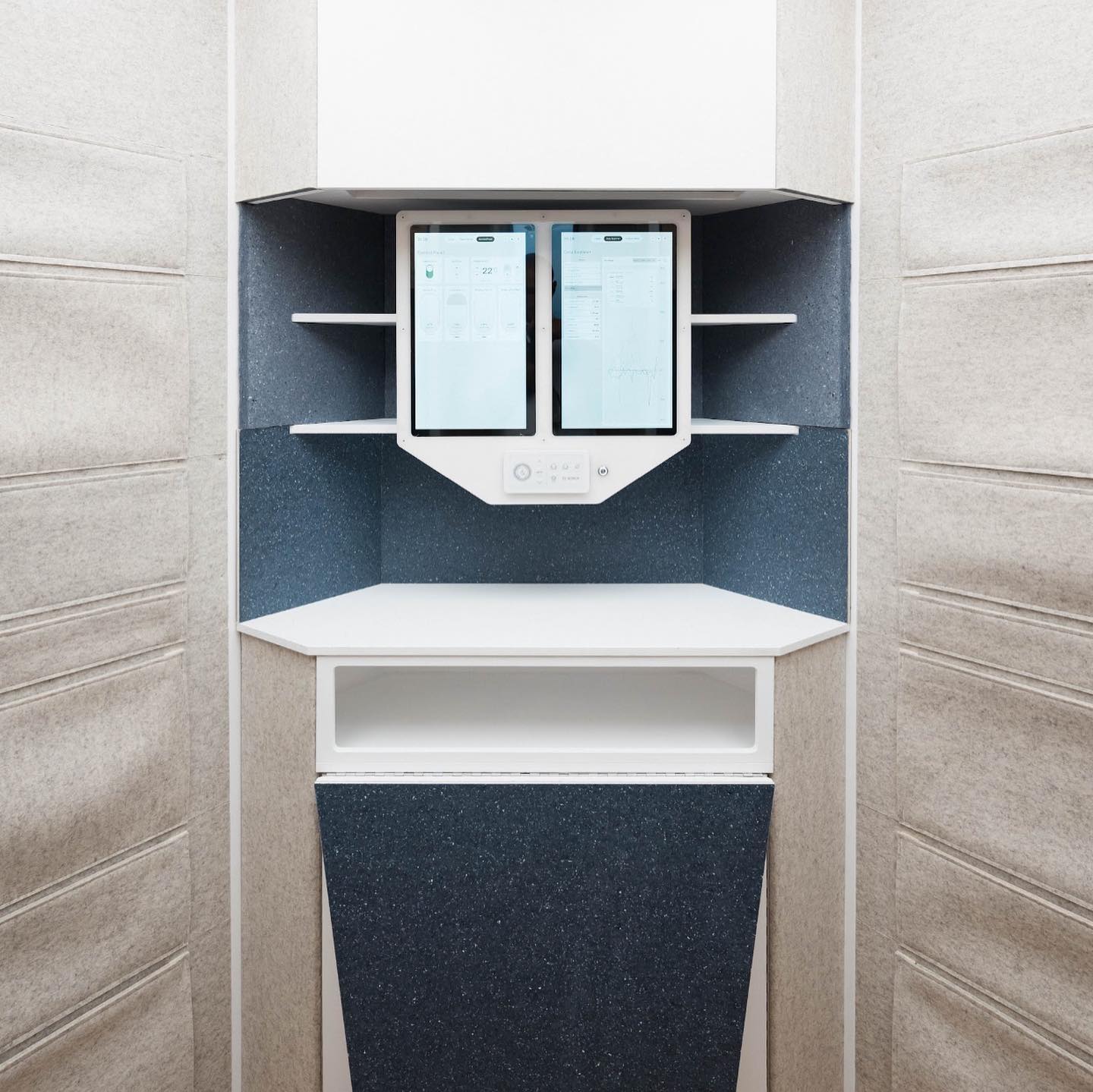
Inside the Rosenberg Space Habitat (RSH) 3D printed polymer habitat. Image courtesy of Institut auf dem Rosenberg.
Experiments at the RSH will explore human well-being, using facilities to test hardware and software tools and applications and develop monitoring tools for remote mission control systems. The boarding school said its learners would also explore the importance of sensory stimulation in remote living environments with light, sound, and smell installations.
“The Rosenberg Space Habitat is state-of-the-art in analog space habitats. It was developed in record time from initial sketches to the final fully functioning habitat in just months,” said Sebastian Frederiksen, founder of SAGA Space Architects. “Furthermore, this is a great example of how working with outer space is pushing the boundaries of technology and architecture here on Earth as well, as this is the tallest 3D-printed plastic ‘house’ in the world. This is just the beginning of the habitat, and now the research and education begin. Hopefully, we are going to learn a lot about living on the Moon.”
Additional features of the RSH include a drone port and the Spot robot, which can go on automated walks, take photos, and collect data in the adjacent Climate Garden, a further collaboration with ETH Zurich.
Subscribe to Our Email Newsletter
Stay up-to-date on all the latest news from the 3D printing industry and receive information and offers from third party vendors.
You May Also Like
Printing Money Episode 17: Recent 3D Printing Deals, with Alex Kingsbury
Printing Money is back with Episode 17! Our host, NewCap Partners‘ Danny Piper, is joined by Alex Kingsbury for this episode, so you can prepare yourself for smart coverage laced...
Insights from Cantor Fitzgerald on AM’s Q1 2024 Landscape
A recent survey by Cantor Fitzgerald sheds light on the persistent challenges within the additive manufacturing (AM) industry in the first quarter of 2024. Based on responses from 38 industry...
3D Printing Financials: Xometry’s Scaling up and Strong Start to 2024
Xometry (Nasdaq: XMTR) kicked off 2024 with strong results, boosting its marketplace and technology to new heights. Both revenue and gross margin soared, fueled by an expanding global network of...
3D Printing Financials: Desktop Metal Targets Recovery Amid Net Losses and Revenue Downturn
Despite facing a decline in revenue and the persistent challenges of a tight economic climate, Desktop Metal (NYSE: DM) is making strides toward operational efficiency. The first quarter of 2024...


